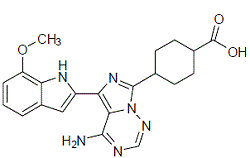| Cas No.: | 936890-98-1 |
| Chemical Name: | (1r,4r)-4-(4-amino-5-(7-methoxy-1H-indol-2-yl)imidazo[1,5-f][1,2,4]triazin-7-yl)cyclohexanecarboxylic acid |
| Synonyms: | OSI027,OSI 027 |
| SMILES: | O=C([C@H]1CC[C@H](C2=NC(C(N3)=CC4=C3C(OC)=CC=C4)=C5C(N)=NC=NN52)CC1)O |
| Formula: | C21H22N6O3 |
| M.Wt: | 406.44 |
| Sotrage: | 2 years -20°C Powder, 2 weeks 4°C in DMSO, 6 months -80°C in DMSO |
| Description: | OSI-027 is an ATP-competitive mTOR kinase activity inhibitor with an IC50 of 4 nM. OSI-027 targets both mTORC1 and mTORC2 with IC50s of 22 nM and 65 nM, respectively. |
| In Vivo: | Effects on GEO colorectal xenograft growth treated with Rapamycin or OSI-027 for 12 days are consistent with our in vitro experiments. Treatment with Rapamycin (20 mg/kg) inhibits phospho-S6 and phospho-4E-BP1, while Akt phosphorylation is increased by 29%. In contrast, OSI-027 (65 mg/kg) inhibits both mTORC1 and mTORC2 effectors. After 2 hours, decreased 4E-BP1, Akt, and S6 phosphorylation is observed and inhibition of S6 and Akt is sustained for 24 hours. The plasma drug concentration of OSI-027 inversely correlated with these effects on mTORC1 and mTORC2 signaling. The median plasma drug concentration with OSI-027 is 21.3 μM at 2 hours and 14.9 μM at 8 hours. The in vivo efficacy of OSI-027 plus Sunitinib is tested in H292 human lung and Ovcar-5 human ovarian xenograft tumors. H292 tumors, treated with OSI-027 (50 mg/kg) for 21 days have 61% median tumor growth inhibition for the duration of treatment (TGI). Sunitinib (40 mg/kg) for 21 days had 47% median TGI. Combining OSI-027 with Sunitinib, however, has a median TGI of 100% with 59% maximal tumor regression, a statistically significant improvement over either agent alone. Ovcar-5 xenograft tumors treated with OSI-027 or Sunitinib have a 55% and 68% median TGI, respectively. OSI-027 administered with Sunitinib has a significantly better median TGI of 100% with 38% maximal tumor regression[1].In the Rapamycin (RAPA) group, three rats exhibit symptoms typical of LTx-aGVHD and die 27 to 35 days after liver transplantation (LT); the remaining five rats do not develop LTx-aGVHD symptoms and survive for more than 100 days. In contrast, seven rats in the OSI-027 group survive for more than 100 days without symptoms of LTx-aGVHD, and only one rat exhibits LTx-aGVHD symptoms and dies on day 33 after LT[2]. |
| In Vitro: | OSI-027 is an ATP-competitive inhibitor, which targets both mTORC1 and mTORC2 with IC50s of 22 nM and 65 nM. OSI-027 also inhibits PI3K-α, PI3K-γ and DNA-PK with IC50s of 1.3 μM, 0.42 μM and 1.0 μM. OSI-027 inhibits mTOR signaling of phospho-4E-BP1 with an IC50 of 1 μM[1]. |

 To enhance service speed and avoid tariff delays, we've opened a US warehouse. All US orders ship directly from our US facility.
To enhance service speed and avoid tariff delays, we've opened a US warehouse. All US orders ship directly from our US facility.




















